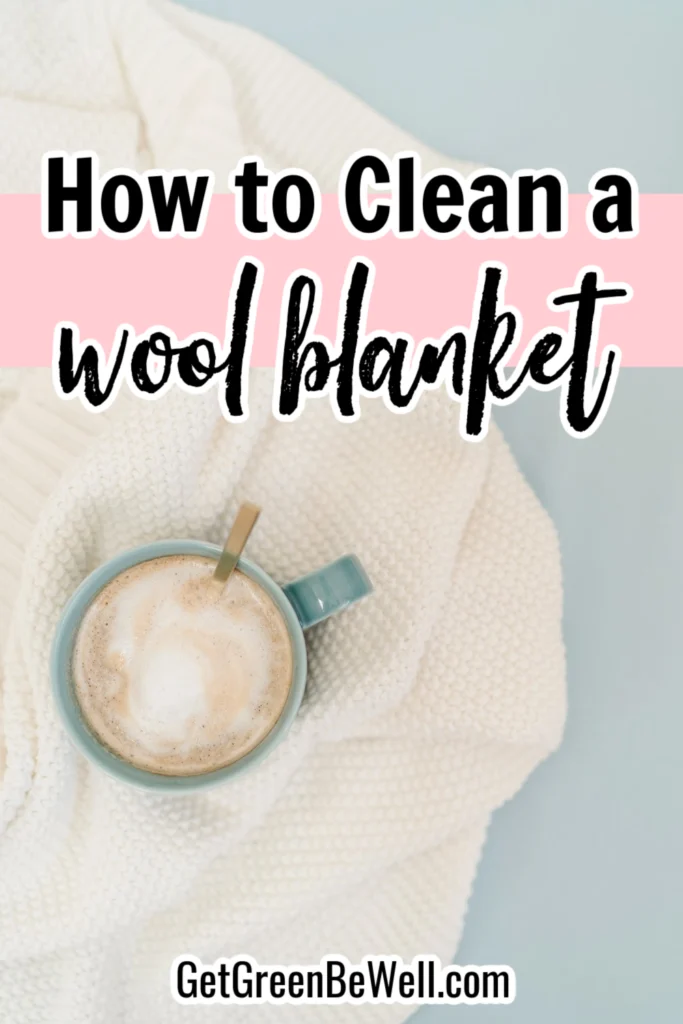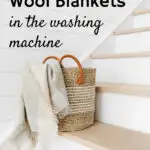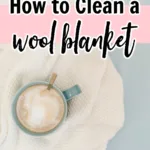Wool is one of my most recommended natural materials for bedding and upholstered items. The durable fibers can stand up to just about anything. They resist stains and moisture, repel dust mites and have natural flame retardant properties. Plus, they are soft, cozy and excellent at temperature regulation all year round.
Even though wool seems to have super powers, it is no match for spilled wine, pet accidents or months of use during cold winter evenings. When it comes time for washing a wool blanket, here’s how to clean wool properly.

If you have a new wool blanket that smells, keep in mind that it is a natural fiber that has a unique smell. Airing out the blanket outside for a few days might be the easiest solution, before washing it. Wet wool can have an odor, too.
How to Clean Wool Blankets
Step 1: Read the Care Label
Read the care instructions. The manufacturer of the blanket is the best resource for directions of how to clean it.
If you haven’t cut off the care tag, read what the directions are. This is where you will find guidance as to whether or not the wool should be washed or dry cleaned, temperatures to avoid, and other helpful hints.
What if the care tag is missing? You can check the manufacturer’s website, if you know what company the wool blanket is from. Or contact their customer service for directions.
Step 2: Shake Off the Blanket
All wool blankets can easily be cleaned just by shaking them out. Dust, debris, hair and bits of who-knows-what from around your home can easily settle into the fibers. Vigorously shaking the blanket can remove a lot of these particles, which can be causing your blanket to smell or look dirty.
If your blanket is too large or heavy to easily shake without touching the floor (and therefore getting dirty again), you could use a soft-bristle brush. Brush the blanket by smoothing the brush down the direction of the fibers, not against them. This will help to dislodge debris and hair, too.
Alternatively, you could use a carpet beater to really dislodge the dust and debris in the blanket. But be careful when using this so you don’t damage the blanket.
You might find that shaking out the blanket freshens it enough to put off a deeper washing for a while.
Step 3: Mend Problem Areas
You don’t want holes or loose threads to cause more damage when in the washer. So be sure to mend holes before washing. Trim loose threads.
Step 4: Spot Clean
If you have a small area that needs to be cleaned, consider spot cleaning it rather than washing the entire blanket. Wool repels moisture and liquid for a certain amount of time. If you spill a glass of milk on a wool blanket, the milk won’t soak into the fibers immediately. Which gives you enough time to spot clean the area.
However, even wool fibers have their limits. Stains will settle in if not treated quickly.
A gentle detergent, especially a wool-safe detergent, is your best bet for spot cleaning a small area. Mix just a little bit of the detergent (a few drops up to ¼ tsp.) with a little water to dilute. Apply to the stained or dirty area with a color-safe towel or washcloth. Rub against the fibers until the stain starts to disappear. Rinse with cool water.
An alternate spot-cleaning tip is to use a solution of 2 parts water with 1 part white distilled vinegar (the best vinegar to clean with).
Step 5: Putting a Wool Blanket in a Washing Machine
For a deep cleaning, you will definitely want to put your blanket in the washing machine. Unless the care tag specifically says “dry clean only.”
Don’t use a normal washing machine detergent for cleaning. Even if you use non-toxic detergents with natural ingredients, they still might be too harsh, especially if they contain enzymes or bleach. You don’t want to ruin the lanolin in the wool fibers. The oily lanolin makes wool soft to the touch. Once you remove it with a harsh detergent, the blanket will never be the same. It will feel rough and scratchy.
Use a wool-safe detergent. I like this wool wash which has lanolin, coconut, aloe vera and tea tree oil for cleaning. Look at the label of your own detergent to see if it is safe for wool.
Another option is to use baby shampoo. One of the most gentle cleaning solutions, it is perfect for wool fibers.
Add your blanket to the washing machine. Ideally, you want to use a washing machine without a center agitator. Allow to soak for up to 15 minutes. Remember, wool fibers repel moisture at first. So you want your blanket to soak in some water before it starts to agitate.
Use the gentle cycle to wash, or use your wool setting if your washing machine has one. Often, the most gentle settings will have a soaking time built in to the wash cycle. So it will depend on your appliance.

There shouldn’t be a spin cycle with the gentle cycle on your washing machine. If there is, see how to turn it off. You don’t want your blanket to be spinning around and getting stretched out of shape or damaged.
Do NOT use warm or hot water when cleaning the blanket. You can shrink the blanket and ruin it!
Alternatively, you could hand wash your blanket in a bathtub filled with water and detergent. The hard part would be rinsing the blanket from the soap residue without wringing it, but it can be done!
Step 6: Air Dry
Do NOT use a dryer to dry a wool blanket! It will be damaged!
Instead, gently pat the blanket in between clean towels to absorb as much moisture as possible. You could also lay the blanket on a layer of towels and gently roll it up, without stretching or pulling it in any way.
Once you have removed as much moisture as possible, it is time to let it air dry. Drape the blanket over a drying rack or hang on a clothesline out of direct sunlight (the sun can fade the fibers and damage the wool). You could also drape over the backs of a couple chairs, over a shower curtain rod, or over the railing of a balcony (again, out of direct sunlight).
If you would like to fluff up the blanket after it is dried, you can put it in a dryer on the No Heat setting to air fluff.
Related Articles
- How to Wash a Backpack in the Washing Machine
- Kill Dust Mites with Freezing Temperatures
- How to Clean a Washing Machine

How Often to Wash Wool Blankets
Because you don’t just toss a wool blanket into a washer and dryer, it takes a lot of time to properly care for this bedding item. You don’t want to clean more often than you need to!
Woolmark suggests cleaning no more than every three months. However, you can go much longer in between cleanings if you treat your blanket properly and don’t have any spills or stains.
Shaking out your wool blanket regularly, and treating problems as they happen, will lengthen the time you need between washings.
Store your blankets folded up nicely, in a dark and cool linen closet, to prevent damage and prolong the time between washings.
Wool blankets are heirloom quality items that can last for generations if treated properly. These tips for washing a wool blanket will allow you to keep your natural fiber blankets for decades of warmth and softness.


